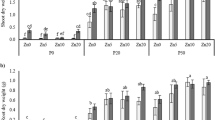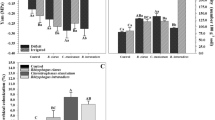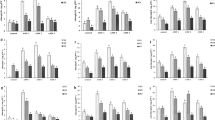Abstract
Although studies of-the biology of mycorrhizas have repeatedly demonstrated their capacity to enhance nutrient capture in circumstances where essential elements are present in growth limiting quantities1–3, knowledge of their function in environments containing potentially toxic concentrations of metallic elements is lacking. It is known that mycorrhizal infection can increase the uptake of copper and zinc from soil solutions containing low concentrations of these metals4, but any such increase in circumstances of high metal concentration would clearly be disadvantageous. Because of the large number of situations, both natural and man-made, in which heavy metal toxicity can restrict plant growth, it is of great ecological and applied interest to increase our understanding of those factors which permit growth of plants on heavily contaminated soils. One of the most successful colonists of such soils in northern Europe is the strongly mycorrhizal ericaceous plant Calluna vulgaris5. Calluna has a characteristic ‘ericoid’ mycorrhizal infection which, in contrast to the situation found in vesicular-arbuscular (VA) mycorrhizas, has been shown primarily to enhance nitrogen rather than phosphorus uptake6,7. We have examined the possibility that mycorrhizal infection may influence the resistance of Calluna to high levels of heavy metals. The growth, survival and heavy metal content of two races of Calluna, one from a metal-polluted site and one from an unpolluted natural heathland, have been compared when plants were grown in the mycorrhizal (M) and non-mycorrhizal (NM) condition in sand cultures supplemented with different levels of copper and zinc. We report here that whereas NM plants show no tolerance of these metals at high concentrations, mycorrhizal infection provides a major degree of resistance to the toxicity and that infection leads to significant reduction of the heavy metal content of the shoot.
This is a preview of subscription content, access via your institution
Access options
Subscribe to this journal
Receive 51 print issues and online access
$199.00 per year
only $3.90 per issue
Buy this article
- Purchase on Springer Link
- Instant access to full article PDF
Prices may be subject to local taxes which are calculated during checkout
Similar content being viewed by others
References
Harley, J. L. in The Biology of Mycorrhiza, 1–334 (Hill, London, 1969).
Tinker, P. B. in Symp. Soc. exp. Biol. 29, 325–349 (1975).
Stribley, D. P. & Read, D. J. in Endomycorrhizas (eds Sanders, F. E., Mosse, B. & Tinker, P. B.) 195–207 (Academic, London, 1975).
Lambert, D. H., Baker, D. E. & Cole, H. J. Soil Sci. Soc. Am. 43, 976–980 (1979).
Marrs, R. H. & Bannister, P. New Phytol. 81, 753–761 (1978).
Read, D. J. & Stribley, D. P. Nature 244, 81–83 (1973).
Read, D. J. & Stribley, D. P. in Endomycorrhizas (eds Sanders, F. E., Mosse, B. & Tinker, P. B.) 105–117 (Academic, London, 1975).
Hewitt, E. J. in Commun. agric. Bur. tech. Comm. 22, 190–191 (1966).
Wu, L., Thurman, D. A. & Bradshaw, A. D. New Phytol. 75, 225–229 (1975).
Turner, R. G. & Marshall, C. New Phytol. 71, 671–676 (1972).
Ashida, J., Higashi, N. & Kikuchi, T. Protoplasma 57, 27–32 (1963).
Rorison, I. H. in Proc. Int. Symp., in Acid Sulphate Soils (ed. Dost, H.) 223–253 (Int. Inst. Land Reclamation & Improvement, Wageningen, 1973).
Author information
Authors and Affiliations
Rights and permissions
About this article
Cite this article
Bradley, R., Burt, A. & Read, D. Mycorrhizal infection and resistance to heavy metal toxicity in Calluna vulgaris. Nature 292, 335–337 (1981). https://doi.org/10.1038/292335a0
Received:
Accepted:
Issue Date:
DOI: https://doi.org/10.1038/292335a0
This article is cited by
-
Metabarcoding of fungal assemblages in Vaccinium myrtillus endosphere suggests colonization of above-ground organs by some ericoid mycorrhizal and DSE fungi
Scientific Reports (2022)
-
Ionomics suggests niche differences between sympatric heathers (Ericaceae)
Plant and Soil (2019)
-
Potential metal-binding ability of proteins in the extracellular slime of Laccaria bicolor exposed to excessive Cu and Cd
Environmental Science and Pollution Research (2019)
-
Vascular plants as ecological indicators of metals in alpine vegetation (Karkonosze, SW Poland)
Environmental Science and Pollution Research (2017)
-
Model systems to unravel the molecular mechanisms of heavy metal tolerance in the ericoid mycorrhizal symbiosis
Mycorrhiza (2016)
Comments
By submitting a comment you agree to abide by our Terms and Community Guidelines. If you find something abusive or that does not comply with our terms or guidelines please flag it as inappropriate.



